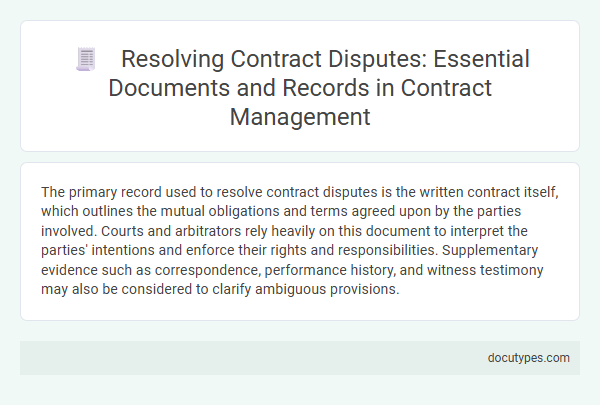The primary record used to resolve contract disputes is the written contract itself, which outlines the mutual obligations and terms agreed upon by the parties involved. Courts and arbitrators rely heavily on this document to interpret the parties' intentions and enforce their rights and responsibilities. Supplementary evidence such as correspondence, performance history, and witness testimony may also be considered to clarify ambiguous provisions.
Introduction to Contract Dispute Resolution
Contract disputes often arise when parties interpret terms differently or fail to meet obligations. Understanding the key records used in resolving these disputes helps protect your rights and interests.
- Contract Document - The primary record detailing the agreed terms, conditions, and responsibilities of each party.
- Communication Records - Emails, letters, and meeting notes that provide context and evidence of negotiations or amendments.
- Performance Evidence - Delivery receipts, invoices, or work reports that demonstrate fulfillment or breach of contract obligations.
Importance of Documentation in Contract Management
Effective contract dispute resolution depends heavily on the accuracy and availability of records. Proper documentation serves as the primary evidence in clarifying the terms and obligations agreed upon by parties.
- Contract Agreements - These legally binding documents outline the responsibilities and expectations that govern the relationship between parties.
- Communication Logs - Emails, letters, and meeting notes provide context and demonstrate the parties' intentions and negotiations.
- Performance Records - Documentation of deliverables, milestones, and payment histories helps verify compliance and identify breaches.
Your ability to resolve disputes swiftly improves when complete, organized documentation is maintained throughout the contract lifecycle.
Types of Essential Contract Documents
| Type of Contract Document | Description | Role in Resolving Contract Disputes |
|---|---|---|
| Written Contract | Formal agreement signed by all parties detailing terms, obligations, and conditions. | Serves as the primary evidence of agreed terms and conditions, often used to interpret the parties' intentions. |
| Amendments and Addenda | Modifications or additions made to the original contract after execution. | Clarify changes in scope or terms, resolving discrepancies about updated obligations. |
| Purchase Orders | Documents issued by a buyer authorizing a purchase under specified terms and prices. | Confirm order details, quantities, and pricing, aiding in payment and delivery disputes. |
| Invoices | Documents issued by a seller requesting payment for goods or services delivered. | Provide proof of delivered goods or completed services and agreed amounts due. |
| Correspondence and Communications | Emails, letters, and messages exchanged between parties discussing contract terms or performance. | Establish intent, clarify misunderstandings, and evidence negotiation history. |
| Performance Records and Reports | Documentation of contract execution such as progress reports, milestones achieved, and delivery receipts. | Support claims regarding fulfillment or breach of contractual obligations. |
| Terms and Conditions | Standard clauses outlining general rules governing the contract. | Define liability, warranties, dispute resolution mechanisms, and remedies. |
Key Records for Contract Dispute Resolution
Contract disputes require precise documentation to ensure fair resolution and enforceability. Key records serve as critical evidence in clarifying the terms and obligations of the parties involved.
- Signed Contract Agreement - The original signed contract is the primary record that outlines the agreed-upon terms between parties.
- Communication Logs - Emails, letters, and other correspondence provide insight into negotiations and any amendments or clarifications made during the contract term.
- Performance Records - Delivery receipts, work reports, and payment records demonstrate fulfillment or breach of contractual obligations.
Role of Contract Amendments and Addenda
What record is used to resolve contract disputes? The primary record utilized in resolving contract disputes is the original contract document along with any contract amendments and addenda. These amendments and addenda play a crucial role by clarifying, modifying, or expanding the terms of the original agreement, ensuring that all parties' intentions are accurately reflected.
Maintaining Communication Logs and Correspondence
Maintaining thorough communication logs and correspondence is essential in resolving contract disputes. These records provide clear evidence of discussions, agreements, and changes throughout the contract lifecycle. You can rely on detailed emails, written notices, and documented phone calls to support your claims effectively.
Evidence Collection: Meeting Minutes and Reports
Meeting minutes and reports serve as critical records in resolving contract disputes. These documents provide a detailed account of discussions, decisions, and actions taken during contractual negotiations or project milestones.
Careful evidence collection through meeting minutes can clarify obligations and identify breaches or misunderstandings. Your ability to present accurate reports often strengthens your position in dispute resolution and legal proceedings.
Document Retention Policies for Contract Management
Contract disputes are primarily resolved using records such as signed agreements, correspondence, and amendments maintained under robust document retention policies. Effective contract management requires systematic storage and easy retrieval of these documents to ensure clarity and evidence during conflicts. Your adherence to comprehensive document retention policies safeguards your interests and supports dispute resolution efficiently.
Best Practices for Organizing Contract Records
The primary record used to resolve contract disputes is the original signed contract along with all related amendments, communications, and performance documentation. These records provide clear evidence of the parties' obligations and any agreed changes.
Best practices for organizing contract records include maintaining a centralized digital repository with indexed files for easy retrieval. Ensure that all correspondence, amendments, and proof of deliverables are consistently logged and linked to the original contract. You should implement version control and secure backups to protect the integrity and accessibility of these critical documents.
What Record Is Used to Resolve Contract Disputes? Infographic

